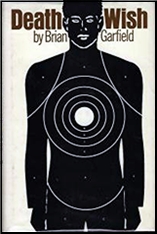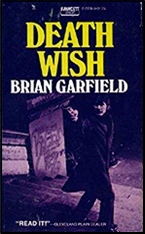Sat 11 May 2019
A PI Mystery Review by David Vineyard: RICHARD S. PRATHER – Strip for Murder.
Posted by Steve under Reviews[6] Comments
RICHARD S. PRATHER – Strip for Murder. Shell Scott #12, Gold Medal #508, paperback original, 1955. Reprinted several times, including Gold Medal s1029, paperback, 1962.
The twelfth Shell Scott adventure features what may be the perfect setup for the white-haired hero, murder in a nudist colony. Shell takes a case from wealthy Vera Redstone that takes him to Fairview after another detective she hired, a friend of Scott’s has been murdered, and Scott is in for a surprise when he arrives because no one bothered to mention he was going undercover with no cover so to speak.
He’s in for no small shock when he is met by a very attractive and very nude young woman who casually informs him where he can remove his clothes.
She laughed. “Don’t be silly. You didn’t expect to keep them on, did you?â€
“Lady. Miss. Peggy. Are there people up there?â€
“Certainly. About a hundred. All the permanent members of Fairview.â€
“Come on, tell me the truth. Don’t they have their clothes on?â€
“Of course not. How silly!â€
“Where am I?†I cried. “What is this place? What have I got into? Are you … nudists?â€
She winced slightly. “Nobody calls us nudists. We’re naturists. Health culturists. Sunbathers. Stop pulling my leg, Mr. Scott. Surely you—â€
“Level with me now. You’re nudists.â€
She shook her head, then laughed slightly. “Well, I suppose in a sense you could call us nudists, if you must have it that way.â€
“Well,†I said, “I have to go. Really I do. It’s been fun, but I really do—â€
After some initial problems with the concept good old Shell gets in the ah … swing of things, and of course, being Prather, there is more than enough pulchritude, violence, mystery, and mayhem to keep the pages rapidly turning.
One of the keys to Prather’s long term success was that on top of writing well and being the fastest quip in the West Shell Scott, while no genius, is a pretty good detective who manages to get involved in interesting cases with clever plots and solutions at the same time he stumbles across beautiful naked women, and increasingly finds himself shedding his own clothes — almost a running gag in the series over the years.
The big influences on Prather were clearly Mickey Spillane and Mike Hammer and equally Robert Leslie Bellem’s Dan Turner, Hollywood Detective, who could almost be Scott’s libidinous father. Indeed, Prather’s clever idea, which many copied but few got half as right, was to marry the violence and brutality of Mike Hammer to the mindset of the Spicy pulps, particularly Bellem’s surreal Dan Turner.
Prather wisely played down some of Bellem’s excesses, but he also took advantage of the freedom offered by the paperback revolution. Just a small random sampling gives you the idea.
But simply to say “another naked woman†is like saying Mount Everest is higher than some hills.
Or
And
And so Scott quips, dodges bullets, flirts with beautiful women, and eventually ends up jousting in full armor.
I didn’t even know what Sardine’s voice sounded like, but my tones were suitably muffled by the helmet — and the customers had hysterics.
“Dropped his lance!†one yelled. “Caught him with his lance down!†Husky allowed himself to laugh with them. There was more laughter while I climbed onto the horse, since the damned armor seemed to weigh a ton—besides which, I’m not accustomed to climbing onto horses. I know nothing at all about plenty of things, but especially horses.
The result was that Scott became what may have been the quintessential fifties and sixties private eye, a big white-haired ex-Marine in a big Cadillac and a tweed sports coat sporting a movie star smile, two lethal fists, and his .38. He was tough, no question of that, but as fast with a quip as he was with his fists, and as a result his adventures were the perfect read for the busy man looking for a smile and a thrill but nothing too challenging.
Like peanuts, you never knew when you had enough Shell Scott. If Michael Shayne and Johnny Liddell were the ideal generic eyes and Hammer the toughest of the tough, Scott carved his own niche halfway between Hammer and Dan Turner, and skillfully mined it again and again, ringing more variations on the theme that it seemed possible whether Scott was swinging from a Hollywood movie set in a loin cloth being chased by gangsters or hiding behind a hollow rock exchanging shots on the set of an adult film in the desert.
Strip for Murder wasn’t Prather’s first foray into a touch of the absurdist, but for me it marked the point when Scott’s adventures stopped being standard Private Eye fare and veered off into an altogether more surrealist venue. From this point on, the thin veneer of reality became almost transparent and Scott’s adventures took on their own special cachet in a world as much Pratherland as La La Land.
After all the hi- and lo-jinks the book ends in a hail of gunfire as appropriate for any Shell Scott adventure. No one can say Prather didn’t choreograph action as well as he did all the tease.
Maybe that was what did it. His gun cracked again and he missed me, though I felt the hot wind hiss past my cheek. Then I saw him, and I was firing again even before my gun was pointed at him. But it was pointed at (SPOILER)’s body before the gun clicked empty. I hit him twice.
Once again Shell Scott survives, gets the girl, and solves the mystery all in a manner that despite the sexism is still highly entertaining to read today. Perhaps because Scott doesn’t quite operate in the real world, its a bit easier to ignore how much Prather was a voice of his time. Scott’s world is unique and his adventures take place in only a vague semblance of the private eye world we all know and love. The mean streets in Pratherland are a yellow brick road we gleefully follow to the wizard and we are seldom disappointed with what is behind the emerald curtain.

